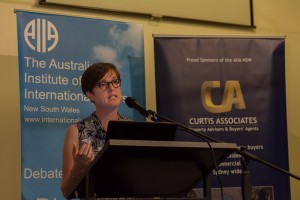Australian Live Animal Exports
The export of live animals is a highly lucrative trade for Australia. But it ignites hot debate, especially between growers and animal rights advocates. Our guest at Glover Cottages on Tuesday 22 March was Dr Bidda Jones, head of the RSPCA science and policy team. She came with her partner Julian Davies, co-authors of Backlash – Australia’s conflict of values over live exports, just launched at the National Library in Canberra by ABC reporter Sarah Ferguson and Independent MP Andrew Wilkie.
Bidda said the treatment of Australian cattle in Indonesia as shown on Four Corners in 2011 horrified large sections of the Australian public. In response, PM Julia Gillard banned the trade for several weeks, but on coming to power Tony Abbott resumed it, calling Gillard’s decision a ‘panicked reaction’, describing the suspension as ‘catastrophic’, and characterising the graziers as victims. Nothing has been done to change the situation, not least the banning of mid-winter Australian loadings of sheep for hot northern hemisphere destinations, where many live animals perished from heat exhaustion.
Bidda said the trade had grown without transparency, ethical oversight or proper government control. Profit-driven proponents of the trade minimise welfare concerns. Traders claim their business has ethical proportions, providing much needed protein to poor countries, employment in their abattoirs, support for their fodder industries, and better technologies for their slaughter houses. Besides, the meat trade is hampered by a lack of refrigerated ships. Other countries would fill the trade if Australia backed out.
Bidda’s response was that Australians lost jobs at Australian abattoirs. Meanwhile, the Commonwealth Department of Agriculture both promoted and regulated the trade – a clear conflict of interests. It had cut itself off from independent advice and was primarily driven by the profit motive. What it and the traders did not accept was that the live animal trade was less profitable than the domestic slaughter of sheep and cattle and export of meat. New Zealand had banned live animal exports and was doing better economically by exporting slaughtered and butchered meat – a classic case of adding value to a raw material, like exporting alumina instead of bauxite, or pig iron instead of iron ore.
Of particular concern to animal rights activists were Australian exports to Indonesia, Vietnam and the Middle East, in the slaughter houses of which cruelty to animals was endemic. China was a comparatively new market, and would grow to dwarf the others. Its slaughter practices might be more civilised, but the profit motive would continue to prevail.
Bidda concluded by saying public opinion in Australia favoured the export of meat over live animals. She and her colleagues in the RSPCA and elsewhere would do their best to continue to raise public awareness until the government of the day acted more responsibly.
Report prepared by Richard Broinowski
